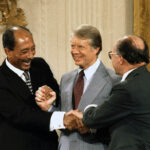A Political Paradox: Power, Fallibility, and the 25th Amendment

President Trump’s hospitalization for Covid-19 has raised a flurry of concerns about the severity of his illness and what it will mean for the election campaign and for the governance of the country. Now Americans are talking about whether power should be transferred to Vice President Pence under the inability clause of the Twenty-Fifth Amendment. But since the ratification of the amendment in 1967, historical patterns indicate that in times of high political tensions, the amendment is unlikely to be invoked. Those closest to the president are actually more likely to remain silent about, or even cover up, the president’s condition, rather than encourage the president to invoke the amendment.
The Twenty-Fifth Amendment was ratified on February 10, 1967, in the wake of the Kennedy assassination and a period of great anxiety about nuclear weapons. The first section deals with a vacancy in the presidency, the second section with a vacancy in the vice presidency. But it is Sections 3 and 4 – dealing with a president unable to discharge his duties – that apply here. Section 3 instructs the president to transmit a written declaration to the president pro tempore of the Senate and the speaker of the House when he is unable to discharge his duties. The vice president then will assume presidential responsibilities as “Acting President” temporarily. This section allows the president to determine when he is able to return to his duties, as does Section 4, which allows the vice president and a majority of the Cabinet to declare the president unfit, if he does not do so himself. The amendment was an attempt to avoid the development of a confused process in which decisions were left unmade or made by a person whose qualifications were not necessarily agreed upon.
The Twenty-Fifth Amendment was invoked just six times between 1967 and the present. During the first
[caption id="attachment_17352" align="alignright" width="150"] Reagan[/caption]
Reagan[/caption]
three invocations, all involving Sections 1 and 2, successful unplanned transitions occurred. But Section 3 was invoked only three times in the last fifty years, despite numerous instances of presidential inability. Examination of the amendment in periods of heightened anxiety during the presidential administration of Ronald Reagan (as well as those of Richard Nixon and George W. Bush) reveal that the amendment did not work as the framers’ intended because the president, in trying to present an image of strength and good health for political reasons, has not often given up power willingly. Section 4 of the amendment has never been invoked due to these same political concerns.
For example, in the hours after the attempted Reagan assassination on March 30, 1981, the amendment was not invoked, even though the president knew he would be unconscious during surgery to repair his punctured lung. While Section 4 of the amendment allows the vice president and a majority of the Cabinet to declare the president incapacitated, Reagan’s Cabinet declined to do so for fear of conveying an impression of weakness. Instead Reagan’s doctors and advisors claimed that Reagan was working for long stretches each day, though this was not the case until almost three weeks later.
The issue arose again six months into Reagan’s second term, when on July 13, 1985, the president underwent an operation to remove polyps from his colon. Although he could have invoked the Twenty-Fifth Amendment, he again did not. During that procedure, the doctors found that Reagan needed major abdominal surgery to remove two feet of intestine around a polyp that was infected with cancer. General anesthesia was required. For this hospitalization, Vice President George H.W. Bush became “acting president,” but Reagan resumed his presidential duties within eight hours; the White House communications team nearby at all times in case of need. The president remained in the hospital for seven days.
Reagan’s autobiography later contained his admission that he “signed a letter invoking the Twenty-Fifth Amendment, making Bush acting president during the time [he] was incapacitated under anesthesia.” He had invoked Section 3 de facto if not de jure. At the time of the surgery, however, Reagan avoided appearances of invoking the amendment. Senator Birch Bayh of Indiana, the chief architect of the amendment, concluded Reagan did not invoke the amendment because of a “tenacious” desire to retain power and a decision “not to trust” anyone else to wield that power. Reagan and his aides also did not want the public, or foreign leaders, to question the physical and mental capabilities of the oldest man (to that date) chosen for Commander in Chief, particularly during an era of heightened nuclear tensions.
[caption id="attachment_79286" align="alignleft" width="150"] Carter, center.[/caption]
Carter, center.[/caption]
Therein lies the inherent flaw in Section 3: political pressures to appear strong and vital militate against its invocation. In 1993, former President Jimmy Carter, part of a commission that studied the inability issue, concluded that the president’s subordinates – including the White House physician who is below the president in the military chain of command – have an inclination to “hide from the public the extent of any inabilities from which the president might suffer.” The president’s coterie derives its power from the president and have not only hesitated to invoke the amendment when he would be non compos mentis, but have even blocked access to him in times of inability.
To make determinations separate from that of the vice president, Cabinet, first lady, and White House physician, a designate from one or both of the other branches of government, such as the chief justice of the Supreme Court, could be allowed access to the president during a specified period of time when his ability is in question. Although the framers ultimately decided not to write specifics into the amendment, because historical patterns illustrate that political considerations have been put above the good of the country, a body of medical experts including a pulmonologist and neurologist should be empowered by Congress to develop a predetermined set of specific circumstances that would automatically trigger Section 3. At the very least, it is time for Congress to answer the clarion call to enact a simple statute to define the term of art “inability,” designate an official consultation group that will determine physical and mental inability, and to clarify the remaining vagaries in the Twenty-Fifth Amendment.
Rebecca Lubot has worked on policy and legislative issues for the Domestic Policy Office of the Vice President, New Jersey State Senator John Girgenti, and United States Senator Frank R. Lautenberg. She holds a Ph.D. from Rutgers University - New Brunswick, a M.Sc. from The London School of Economics, and a B.A. from Boston University.






How safe are Mail-in Ballots???? https://www.texastribune.org/2020/10/08/voting-fraud-arrest-carrollton/
Is there no bottom to the depths of the Trump Derangement Syndrome that has infected much of the opposition to the November 2016 election of Trump. This has now reached a fevered pitch that probably won't even break if the President is successful in winning another victory, but just might if he can force the release of the up until now "Classified" AKA: hidden notes, detailing the concerted effort to conduct a Coup against his election. The recent release of just a few of those Treasonous excerpts, if accompanied by the full second dose, is potentially the needed ammount of reality that may break that political fever. I had warned in a meeting with one of the N.J. Congressional members staff, that events playing out nationally may signal the end of the Democratic Party because of the activity being engaged in, in full view of the American electorate.